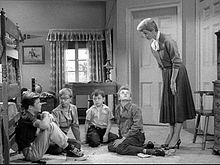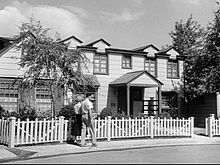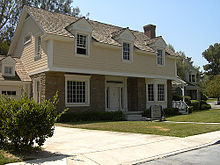Leave It to Beaver
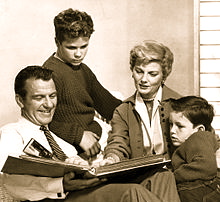
Leave It To Beaver : Wally’s Dinner Date
When Wally invites his girlfriend to dinner at the White Fox, he doesn’t realize it’s the most expensive place in town. To make matters worse – he forgets his wallet.
Leave It to Beaver cast (L–R): Hugh Beaumont, Tony Dow Barbara Billingsley and Jerry Mathers, circa 1959
Leave It to Beaver is an American television situation comedy about an inquisitive but often naïve boy named Theodore “The Beaver” Cleaver (portrayed by Jerry Mathers) and his adventures at home, in school, and around his suburban neighborhood. The show also starred Barbara Billingsley and Hugh Beaumont as Beaver’s parents, June and Ward Cleaver, and Tony Dow as Beaver’s brother Wally. The show has attained an iconic status in the US, with the Cleavers exemplifying the idealized suburban family of the mid-20th century.
One of the first primetime sitcom series written from a child’s point-of-view, the show was created by the writers Joe Connelly and Bob Mosher. These veterans of radio and early television found inspiration for the show’s characters, plots, and dialogue in the lives, experiences, and conversations of their own children. Like several television dramas and sitcoms of the late 1950’s and early 1960’s (Lassie and My Three Sons, for example),Leave It to Beaver is a glimpse at middle-class, white American boyhood. In a typical episode Beaver got into some sort of trouble, then faced his parents for reprimand and correction. However, neither parent was omniscient; indeed, the series often showed the parents debating their approach to child rearing, and some episodes were built around parental gaffes.
With six full 39-week seasons (234 episodes), the show had its debut on CBS on October 4, 1957, and then moved to ABC the following year, completing its run on June 20, 1963. Although television production was transitioning from black-and-white to color in the latter years of the show’s run, the series continued to be shot with a single camera on black-and-white 35mm film. The show’s production companies included comedian George Gobel‘s Gomalco Productions (1957–1961) and Kayro Productions (1961–1963) with filming at Revue Studios/Republic Studios and Universal Studios in Los Angeles, California. The show was distributed by MCA Television.
The still-popular show was canceled in 1963 because the stars wanted to move on. Jerry Mathers was entering his freshman year in high school and actor Tony Dow was about to graduate from high school.
Contemporary commentators praised Leave It to Beaver, with Variety comparing Beaver to Mark Twain‘s Tom Sawyer. Much juvenile merchandise was released during the show’s first-run including board games, novels, and comic books. The show has enjoyed a renaissance in popularity since the 1970s through off-network syndication, a reuniontelemovie, Still the Beaver (1983), and a sequel series The New Leave It to Beaver (1985–89). In 1997, a movie version based on the original series was released to moderate acclaim, and, in October 2007, TV Land celebrated the show’s 50th anniversary with a marathon. Although the show never broke into the Nielsen ratings top-30 nor won any awards, it placed on TIME magazine’s unranked 2007 list of “The 100 Best TV Shows of All-TIME.”
According to Tony Dow, “if any line got too much of a laugh, they’d take it out. They didn’t want a big laugh; they wanted chuckles.”
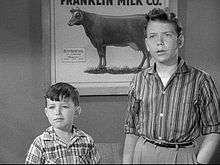 Jerry Mathers and Paul Sullivan, Settings – Time setting
Jerry Mathers and Paul Sullivan, Settings – Time setting
The time setting of Leave It to Beaver is contemporary with its production—the late 1950’s and the early 1960’s. Though the show had its debut the same day Sputnik was launched into space and left the air a few months before the assassination of John F. Kennedy, references to contemporary news issues or topics are infrequent. Communism is mentioned in “Water, Anyone?”
Contemporary cultural references are more frequent but not overwhelming. The show acknowledges the greaser subculture and, in the last season, “The Twist”, a popular song and dance craze of the early 1960s. The dance’s promoter, Chubby Checker, is hinted at in the episode’s fictional “Chubby Chadwick” and his fictional hit tune, “Surf Board Twist”. Wally and his friends perform a tepid version of The Twist at Wally’s party in “The Party Spoiler”. The 1960 Kirk Douglas vehicle Spartacus is brought up, Eisenhower is mentioned and, in one episode, Beaver’s best friend Gilbert says Angela Valentine wore a “Jackie Kennedy wig” to class. Contemporary celebrities mentioned on the show include Rock Hudson, Tuesday Weld, Sal Mineo, Frank Sinatra, Tony Curtis, Sonny Liston, Cassius Clay, Chet Huntley, David Brinkley, Jack Paar, John Glenn, Warren Spahn, Fabian and others. Then current Los Angeles Dodgers celebrity star Don Drysdale appears as himself in one episode. When Beaver appears on a TV show, not knowing it is being recorded to air another day, Gilbert compares the misunderstanding with “a Rod Serling Twilight Zone“. The episode in which Beaver graduates from grammar school (8th grade) is perhaps the only time a year is mentioned. June and Ward inspect the gift they have for Beaver’s graduation and read the inscription, “…Class of ’63”.
June supervises the boys and their friends, Tooey and Eddie.
Leave It to Beaver is set in the fictitious community of Mayfield and its environs. The principal setting is the Cleaver home. The Cleavers live in two houses over the series’ run. The “move” was necessary when the façade of the original house—located at Republic Studios—became unavailable for filming following the production’s move to Universal. The “new house” stood on the Universal backlot. The first house is ‘located’ at 485 Mapleton (sometimes Maple) Drive, and the second at 211 Pine Street. In an early episode set in the Mapleton Drive house, Beaver speaks of living in another house where he suffered the measles and became attached to “Billy,” his first teddy bear. In another episode Beaver indicates the Mapleton Drive house was the first house he’d ever lived in.
Social and ethnic setting
Characters are nearly uniformly white, middle-class and heterosexual. Only one African-American had a speaking role during the run of the series; in 1963, Kim Hamilton played a maid in episode 212, “The Parking Attendants.” Five years earlier, an episode featured a Hispanic family, as Alan Roberts Costello played Roberto “Chuey” Varella, a friend and weekend house guest of the Beaver in 1959’s “Beaver and Chuey.” The friend spoke only Spanish, leading to a cruel Eddie Haskell prank. There were no apparent lesbian or gay characters.
Surrounded by a picket fence, the Mapleton Drive house is two stories with a first floorkitchen, dining room, living room and adjoining patio, and at least three bedrooms on the second floor—one for the boys, one for the parents, and a guest room into which Beaver moves for a night. In one episode, Wally ventures into the cellar. A kitchen door opens onto a small side yard, the driveway, and a single-car garage—a frequent setting for get-togethers between the boys, their father, and their friends.
Toward the close of season two, the Cleavers discuss moving. In the season’s closer, Ward tells the boys the Mapleton Drive house has been sold. In the season three opener, the Cleavers are comfortably settled in a new house at 211 Pine Street. No episode features the actual move.
Pine Street house
The Pine Street house consists of several rooms (kitchen and laundry room, dining room, living room, den) on the ground floor and at least three bedrooms on the second floor. None of the furnishings from the Mapleton Drive house appear in the new house. Reproductions of Gainsborough‘s The Blue Boy and Lawrence‘s Pinkie hang in the front entry above graceful bergères. An upholsteredwing chair at the edge of the hearth in the living room is covered in a chinoiserie print.
After the move to Pine Street, the boys continue to attend the same schools, frequent the same hang outs, and visit the same friends. The Pine Street house is in the vicinity of the Mapleton Drive house; in one episode, Beaver and Larry walk to the Mapleton Drive house, uproot a small tree, and transport it to the Pine Street house in a wagon.
In the Pine Street house, Ward has a den near the main entry, which serves as a setting for many scenes. The garage at the Pine Street house is used less often as a setting for masculine get-togethers than the Mapleton Drive garage had been. June and Ward’s bedroom is seen for the first time in the Pine Street house. They have their own bath, sleep in twin beds, and have a portable TV in the room.
Two years before Leave It to Beaver went into production, the Pine Street façade and its neighborhood were employed extensively in the 1955 Humphrey Bogart film, The Desperate Hours.
In 1969, the Pine Street house was reused for another Universal-produced television hit, Marcus Welby, M.D. This house can still be seen at Universal Studios, though the original façade was replaced in 1988 for the following year’s The ‘Burbs and sat in storage elsewhere on the Universal lot. The façade was replaced again for the 1996 Leave It to Beaver movie. The house and the street it sits on were used as the main exterior set for Wisteria Lane of Desperate Housewives, and was also previously used as the Pearson family house on The Bill Engvall Show.


